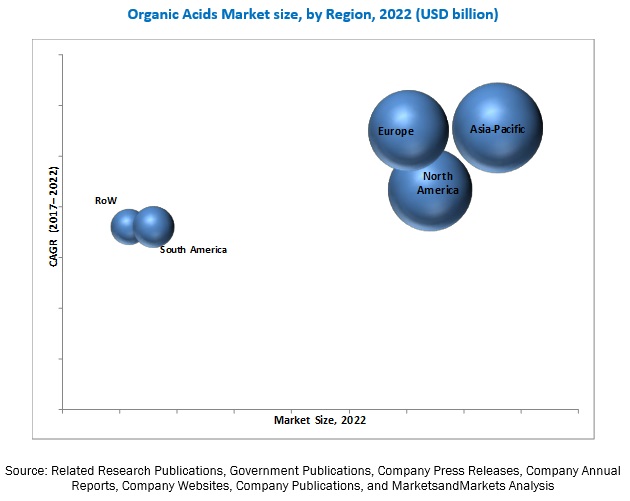Growth in Demand for Convenience Food Drives the Organic Acids Market
The report "Organic Acids Market by Type (Acetic Acid, Citric Acid, Formic Acid, Lactic Acid, Propionic Acid, Ascorbic Acid, Gluconic Acid, Fumaric Acid), Application (Food & Beverages, Feed, Pharmaceuticals, and Industrial), and Region - Global Forecast to 2022", The organic acids market is projected to reach a value of USD 11.39 Billion by 2022, at a CAGR of 5.48% from 2017 to 2022. The market is driven by factors such as the use of organic acids in various applications and wide functionalities of organic acids range from their use as a preservative, acidity regulator, antioxidant, flavor enhancer, coating, and in the production of biopolymers.
The periodization of the entire study period considered is as follows:
Base year: 2016
Forecast period: 2017–2022

The objectives of the study are as follows:
To define, segment, and project the global organic acids market size with respect to type, application, and key regions
To provide detailed information about the major factors influencing the growth of the market (drivers, restraints, opportunities, and industry-specific challenges)
To analyze opportunities in the market for stakeholders and provide the competitive landscape of market leaders
To project the size of the market and its submarkets in terms of value and volume, with respect to regions (along with key countries)
To strategically profile key players and comprehensively analyze their product portfolio and core competencies in the organic acids market
Download PDF Brochure: https://www.marketsandmarkets.com/pdfdownloadNew.asp?id=30190158
The acetic acid segment, accounted for the largest share in the organic acids market in 2016.
On the basis of type, the acetic acid segment accounted for the largest share in the organic acids market in 2016 followed by citric acid. Acetic acid is used majorly in food & beverage industries due to its antibacterial and antifungal properties. Bakery and confectionery industries use acetic acid and citric acid to prevent bacterial and fungal growth in their products. Citric acid also has applications as a cleaning and chelating agent, water treating solvent, and in the cosmetics industry.
Food & beverage application segment accounted for the largest share in the organic acids market in 2016
Organic acids are used extensively in food & beverages. Acidic extracts may act as buffers to regulate acidity, antioxidants, preservatives, and flavor enhancers in food-grade products. Although organic acids have been used to counteract pathogens in food for many years, there is an important need to evaluate and improve their continued effectiveness and sustainability. There is also a growing demand for foods that are produced using milder treatments, which include heat, salt, sugar, and chemicals. New technologies to prevent the growth of harmful bacteria are introduced, thereby increasing the demand for organic acids in food & beverages applications.
Speak to Analyst: https://www.marketsandmarkets.com/speaktoanalystNew.asp?id=30190158
Asia-Pacific dominated the organic acids market in 2016
The Asia-Pacific region was the largest market for organic acids in 2016. This can be attributed to the increase in demand for various organic acid fortified products in the Asian region. Consumer awareness related to natural organic acid consumption in this region is increasing, and can be attributed for its largest market share for this market. Many big players have established their production plants in this region.
This report includes a study of marketing and development strategies, along with the product portfolios of the leading companies. It includes profiles of leading companies such as Cargill (U.S.), BASF SE (Germany), Dow Chemical Company (U.S.), Henan Jindan Lactic Acid Technology Co. Ltd (China), Archer Daniels Midland Company (U.S.), Eastman Chemical Company (U.S.), Corbion (Netherlands), Myriant Corporation (U.S.), Polynt-Reichhold (Italy), Tate & Lyle (U.K.), Koninklijke DSM N.V. (Netherlands), and E.I. Du Pont De Nemours & Company (U.S.).
